A Study of Poverty and Income Inequality in China: Causes and Effects
VerifiedAdded on 2023/06/11
|11
|2830
|243
Essay
AI Summary
This essay examines the critical political and economic issue of poverty and income inequality in China, highlighting the disparities between urban and rural populations and the widening gap between the rich and the poor. It discusses how rapid economic growth and urbanization have disproportionately benefited wealthier segments of society, while a significant portion of the population, particularly in rural areas, continues to struggle with poverty. The essay references China's Gini coefficient as an indicator of wealth distribution and emphasizes the need for further research, particularly primary data collection, to fully understand the effects of income inequality and to develop effective strategies for addressing this pressing challenge. Desklib provides access to this and other student-contributed essays, along with AI-powered study tools to aid in academic success.
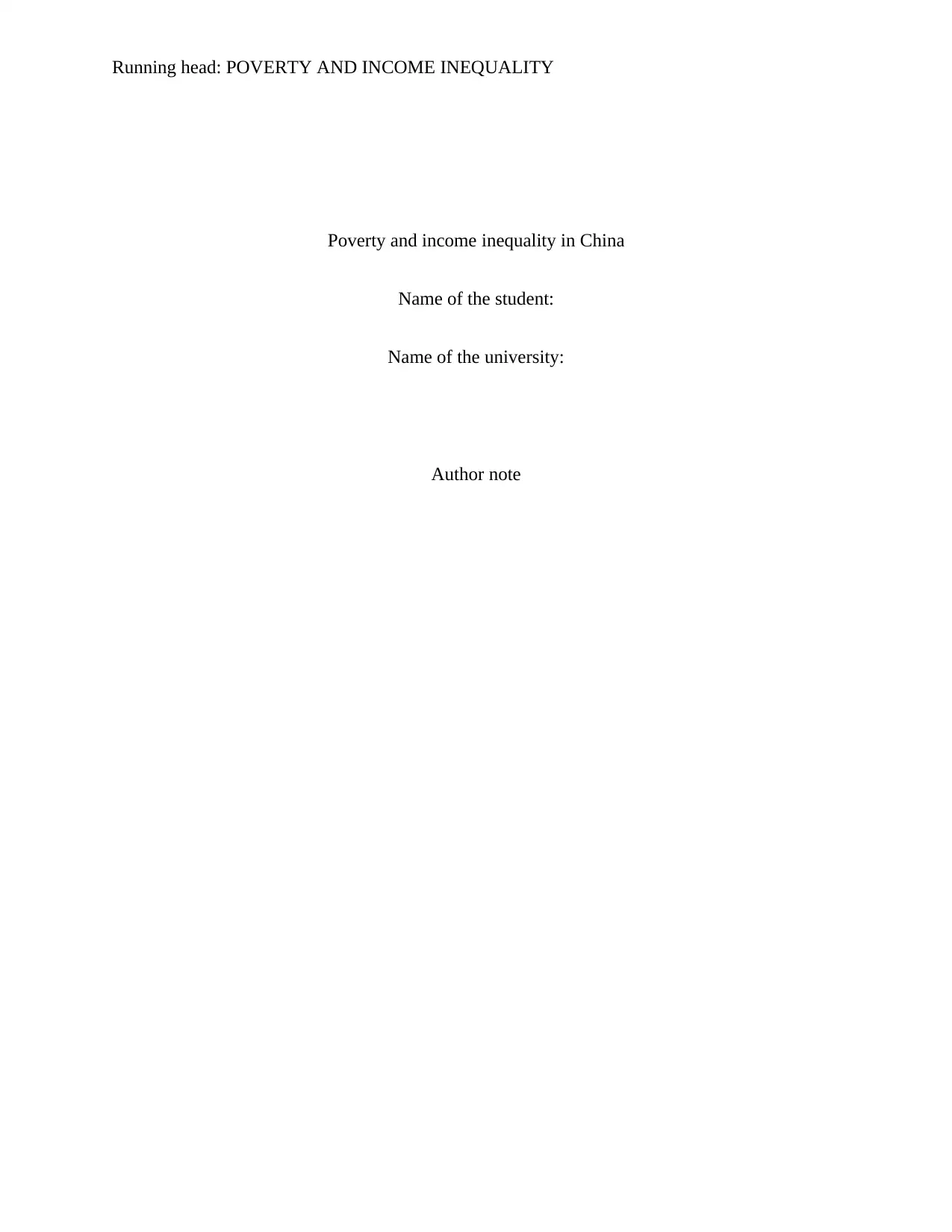
Running head: POVERTY AND INCOME INEQUALITY
Poverty and income inequality in China
Name of the student:
Name of the university:
Author note
Poverty and income inequality in China
Name of the student:
Name of the university:
Author note
Paraphrase This Document
Need a fresh take? Get an instant paraphrase of this document with our AI Paraphraser
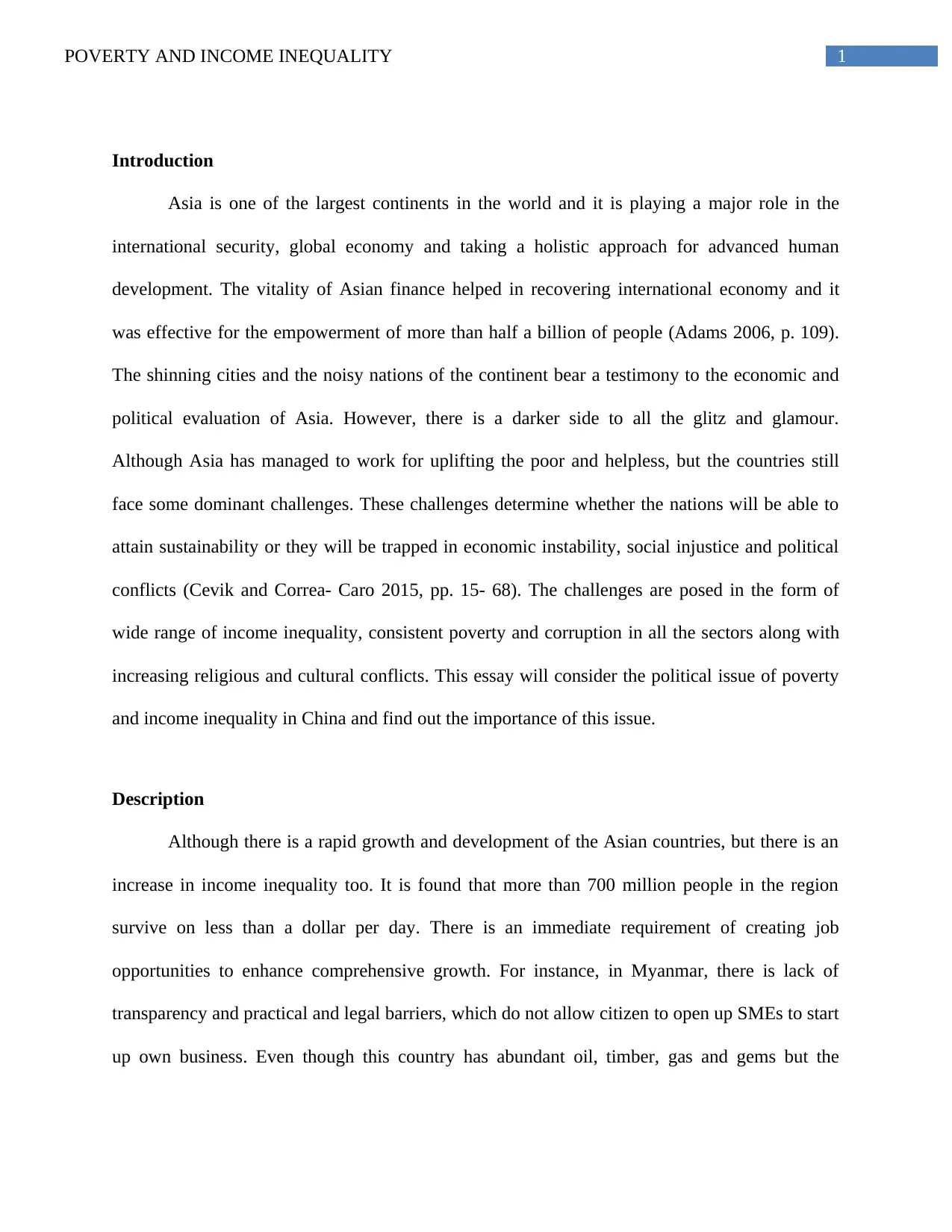
1POVERTY AND INCOME INEQUALITY
Introduction
Asia is one of the largest continents in the world and it is playing a major role in the
international security, global economy and taking a holistic approach for advanced human
development. The vitality of Asian finance helped in recovering international economy and it
was effective for the empowerment of more than half a billion of people (Adams 2006, p. 109).
The shinning cities and the noisy nations of the continent bear a testimony to the economic and
political evaluation of Asia. However, there is a darker side to all the glitz and glamour.
Although Asia has managed to work for uplifting the poor and helpless, but the countries still
face some dominant challenges. These challenges determine whether the nations will be able to
attain sustainability or they will be trapped in economic instability, social injustice and political
conflicts (Cevik and Correa- Caro 2015, pp. 15- 68). The challenges are posed in the form of
wide range of income inequality, consistent poverty and corruption in all the sectors along with
increasing religious and cultural conflicts. This essay will consider the political issue of poverty
and income inequality in China and find out the importance of this issue.
Description
Although there is a rapid growth and development of the Asian countries, but there is an
increase in income inequality too. It is found that more than 700 million people in the region
survive on less than a dollar per day. There is an immediate requirement of creating job
opportunities to enhance comprehensive growth. For instance, in Myanmar, there is lack of
transparency and practical and legal barriers, which do not allow citizen to open up SMEs to start
up own business. Even though this country has abundant oil, timber, gas and gems but the
Introduction
Asia is one of the largest continents in the world and it is playing a major role in the
international security, global economy and taking a holistic approach for advanced human
development. The vitality of Asian finance helped in recovering international economy and it
was effective for the empowerment of more than half a billion of people (Adams 2006, p. 109).
The shinning cities and the noisy nations of the continent bear a testimony to the economic and
political evaluation of Asia. However, there is a darker side to all the glitz and glamour.
Although Asia has managed to work for uplifting the poor and helpless, but the countries still
face some dominant challenges. These challenges determine whether the nations will be able to
attain sustainability or they will be trapped in economic instability, social injustice and political
conflicts (Cevik and Correa- Caro 2015, pp. 15- 68). The challenges are posed in the form of
wide range of income inequality, consistent poverty and corruption in all the sectors along with
increasing religious and cultural conflicts. This essay will consider the political issue of poverty
and income inequality in China and find out the importance of this issue.
Description
Although there is a rapid growth and development of the Asian countries, but there is an
increase in income inequality too. It is found that more than 700 million people in the region
survive on less than a dollar per day. There is an immediate requirement of creating job
opportunities to enhance comprehensive growth. For instance, in Myanmar, there is lack of
transparency and practical and legal barriers, which do not allow citizen to open up SMEs to start
up own business. Even though this country has abundant oil, timber, gas and gems but the
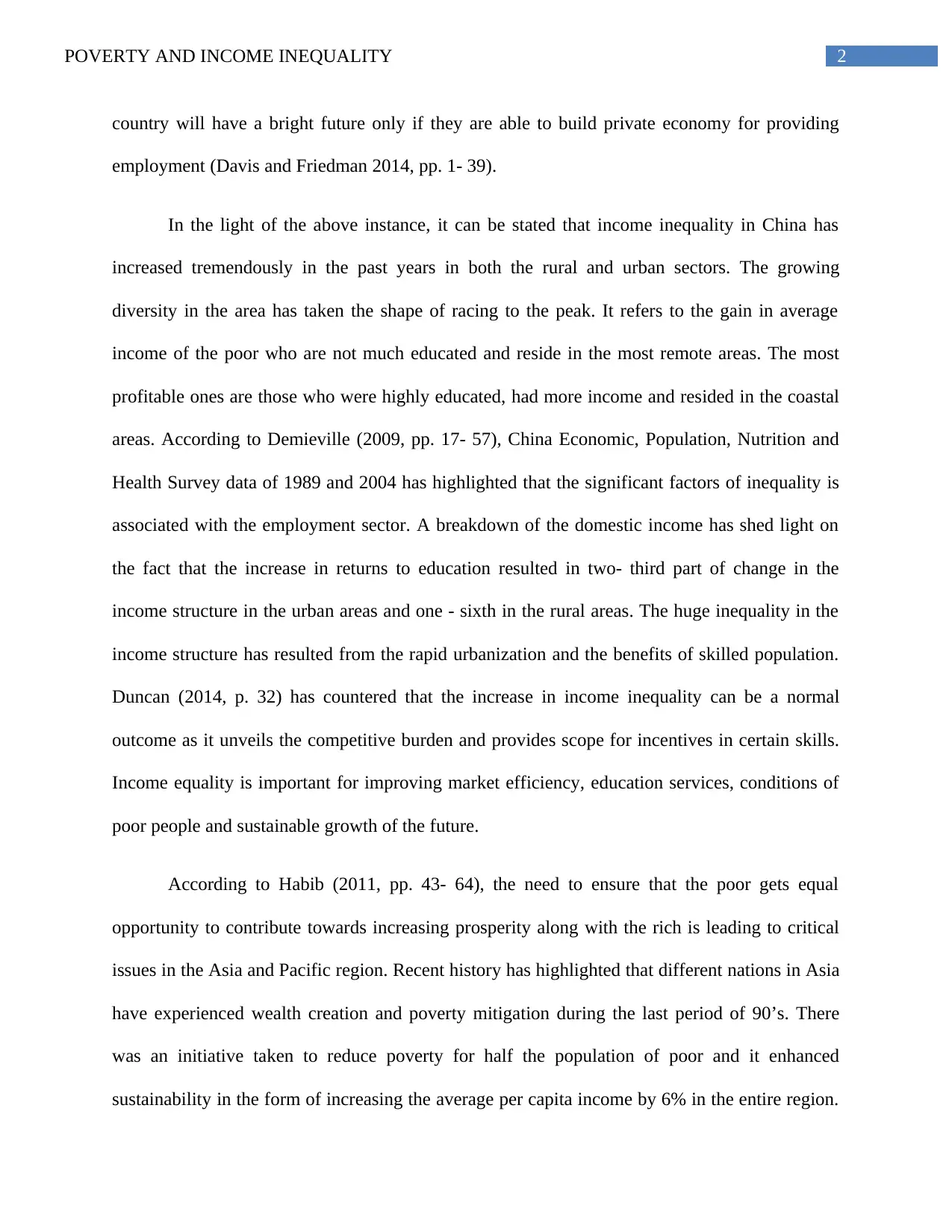
2POVERTY AND INCOME INEQUALITY
country will have a bright future only if they are able to build private economy for providing
employment (Davis and Friedman 2014, pp. 1- 39).
In the light of the above instance, it can be stated that income inequality in China has
increased tremendously in the past years in both the rural and urban sectors. The growing
diversity in the area has taken the shape of racing to the peak. It refers to the gain in average
income of the poor who are not much educated and reside in the most remote areas. The most
profitable ones are those who were highly educated, had more income and resided in the coastal
areas. According to Demieville (2009, pp. 17- 57), China Economic, Population, Nutrition and
Health Survey data of 1989 and 2004 has highlighted that the significant factors of inequality is
associated with the employment sector. A breakdown of the domestic income has shed light on
the fact that the increase in returns to education resulted in two- third part of change in the
income structure in the urban areas and one - sixth in the rural areas. The huge inequality in the
income structure has resulted from the rapid urbanization and the benefits of skilled population.
Duncan (2014, p. 32) has countered that the increase in income inequality can be a normal
outcome as it unveils the competitive burden and provides scope for incentives in certain skills.
Income equality is important for improving market efficiency, education services, conditions of
poor people and sustainable growth of the future.
According to Habib (2011, pp. 43- 64), the need to ensure that the poor gets equal
opportunity to contribute towards increasing prosperity along with the rich is leading to critical
issues in the Asia and Pacific region. Recent history has highlighted that different nations in Asia
have experienced wealth creation and poverty mitigation during the last period of 90’s. There
was an initiative taken to reduce poverty for half the population of poor and it enhanced
sustainability in the form of increasing the average per capita income by 6% in the entire region.
country will have a bright future only if they are able to build private economy for providing
employment (Davis and Friedman 2014, pp. 1- 39).
In the light of the above instance, it can be stated that income inequality in China has
increased tremendously in the past years in both the rural and urban sectors. The growing
diversity in the area has taken the shape of racing to the peak. It refers to the gain in average
income of the poor who are not much educated and reside in the most remote areas. The most
profitable ones are those who were highly educated, had more income and resided in the coastal
areas. According to Demieville (2009, pp. 17- 57), China Economic, Population, Nutrition and
Health Survey data of 1989 and 2004 has highlighted that the significant factors of inequality is
associated with the employment sector. A breakdown of the domestic income has shed light on
the fact that the increase in returns to education resulted in two- third part of change in the
income structure in the urban areas and one - sixth in the rural areas. The huge inequality in the
income structure has resulted from the rapid urbanization and the benefits of skilled population.
Duncan (2014, p. 32) has countered that the increase in income inequality can be a normal
outcome as it unveils the competitive burden and provides scope for incentives in certain skills.
Income equality is important for improving market efficiency, education services, conditions of
poor people and sustainable growth of the future.
According to Habib (2011, pp. 43- 64), the need to ensure that the poor gets equal
opportunity to contribute towards increasing prosperity along with the rich is leading to critical
issues in the Asia and Pacific region. Recent history has highlighted that different nations in Asia
have experienced wealth creation and poverty mitigation during the last period of 90’s. There
was an initiative taken to reduce poverty for half the population of poor and it enhanced
sustainability in the form of increasing the average per capita income by 6% in the entire region.
⊘ This is a preview!⊘
Do you want full access?
Subscribe today to unlock all pages.

Trusted by 1+ million students worldwide
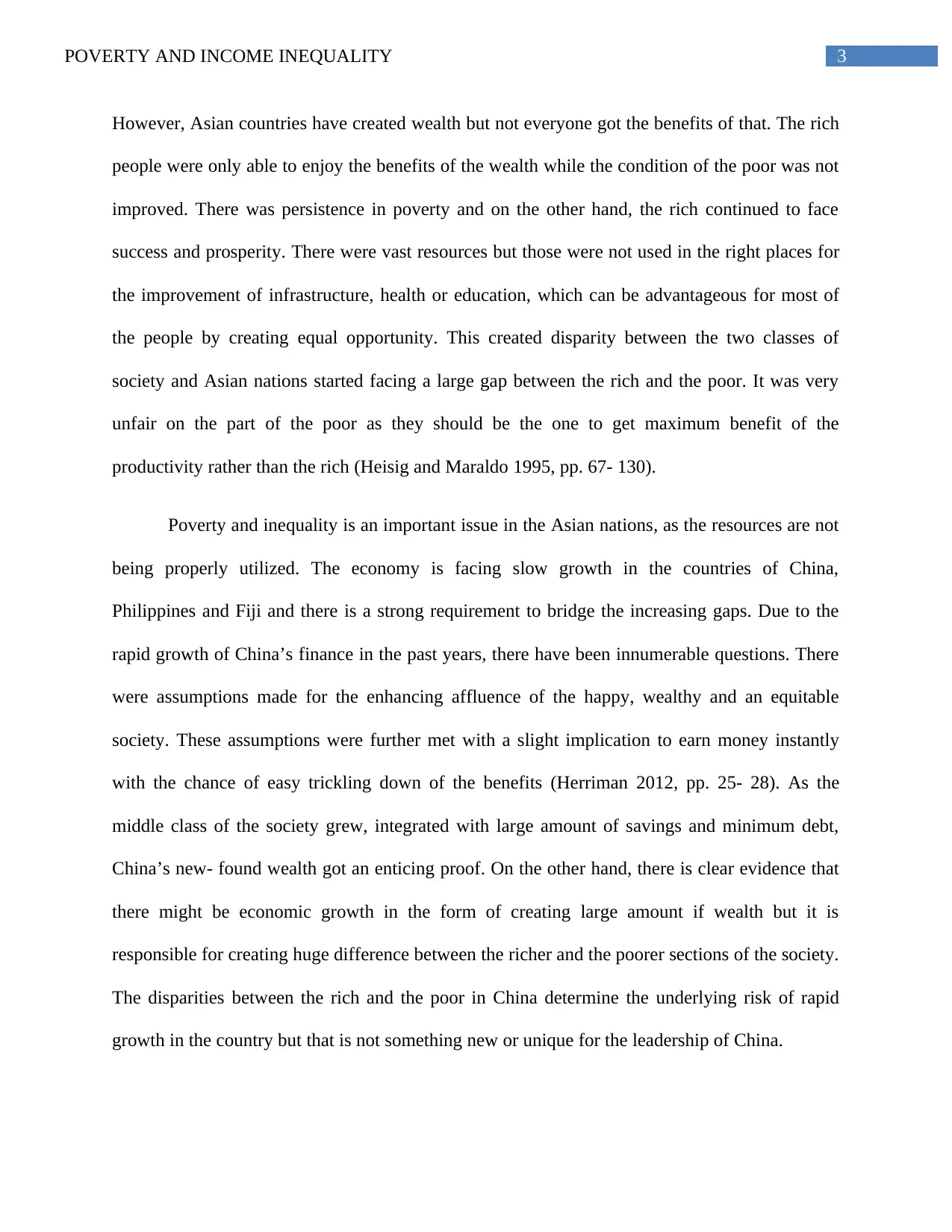
3POVERTY AND INCOME INEQUALITY
However, Asian countries have created wealth but not everyone got the benefits of that. The rich
people were only able to enjoy the benefits of the wealth while the condition of the poor was not
improved. There was persistence in poverty and on the other hand, the rich continued to face
success and prosperity. There were vast resources but those were not used in the right places for
the improvement of infrastructure, health or education, which can be advantageous for most of
the people by creating equal opportunity. This created disparity between the two classes of
society and Asian nations started facing a large gap between the rich and the poor. It was very
unfair on the part of the poor as they should be the one to get maximum benefit of the
productivity rather than the rich (Heisig and Maraldo 1995, pp. 67- 130).
Poverty and inequality is an important issue in the Asian nations, as the resources are not
being properly utilized. The economy is facing slow growth in the countries of China,
Philippines and Fiji and there is a strong requirement to bridge the increasing gaps. Due to the
rapid growth of China’s finance in the past years, there have been innumerable questions. There
were assumptions made for the enhancing affluence of the happy, wealthy and an equitable
society. These assumptions were further met with a slight implication to earn money instantly
with the chance of easy trickling down of the benefits (Herriman 2012, pp. 25- 28). As the
middle class of the society grew, integrated with large amount of savings and minimum debt,
China’s new- found wealth got an enticing proof. On the other hand, there is clear evidence that
there might be economic growth in the form of creating large amount if wealth but it is
responsible for creating huge difference between the richer and the poorer sections of the society.
The disparities between the rich and the poor in China determine the underlying risk of rapid
growth in the country but that is not something new or unique for the leadership of China.
However, Asian countries have created wealth but not everyone got the benefits of that. The rich
people were only able to enjoy the benefits of the wealth while the condition of the poor was not
improved. There was persistence in poverty and on the other hand, the rich continued to face
success and prosperity. There were vast resources but those were not used in the right places for
the improvement of infrastructure, health or education, which can be advantageous for most of
the people by creating equal opportunity. This created disparity between the two classes of
society and Asian nations started facing a large gap between the rich and the poor. It was very
unfair on the part of the poor as they should be the one to get maximum benefit of the
productivity rather than the rich (Heisig and Maraldo 1995, pp. 67- 130).
Poverty and inequality is an important issue in the Asian nations, as the resources are not
being properly utilized. The economy is facing slow growth in the countries of China,
Philippines and Fiji and there is a strong requirement to bridge the increasing gaps. Due to the
rapid growth of China’s finance in the past years, there have been innumerable questions. There
were assumptions made for the enhancing affluence of the happy, wealthy and an equitable
society. These assumptions were further met with a slight implication to earn money instantly
with the chance of easy trickling down of the benefits (Herriman 2012, pp. 25- 28). As the
middle class of the society grew, integrated with large amount of savings and minimum debt,
China’s new- found wealth got an enticing proof. On the other hand, there is clear evidence that
there might be economic growth in the form of creating large amount if wealth but it is
responsible for creating huge difference between the richer and the poorer sections of the society.
The disparities between the rich and the poor in China determine the underlying risk of rapid
growth in the country but that is not something new or unique for the leadership of China.
Paraphrase This Document
Need a fresh take? Get an instant paraphrase of this document with our AI Paraphraser
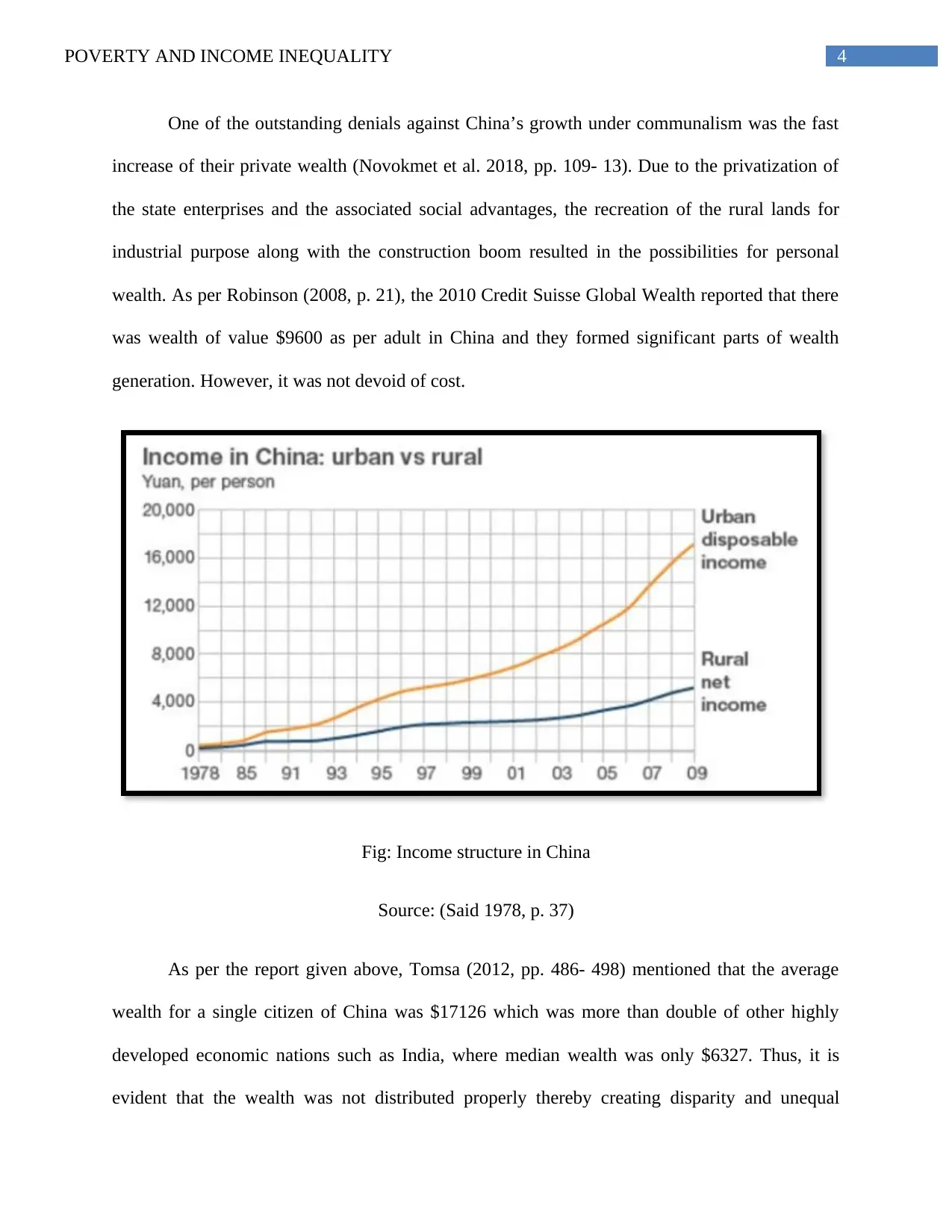
4POVERTY AND INCOME INEQUALITY
One of the outstanding denials against China’s growth under communalism was the fast
increase of their private wealth (Novokmet et al. 2018, pp. 109- 13). Due to the privatization of
the state enterprises and the associated social advantages, the recreation of the rural lands for
industrial purpose along with the construction boom resulted in the possibilities for personal
wealth. As per Robinson (2008, p. 21), the 2010 Credit Suisse Global Wealth reported that there
was wealth of value $9600 as per adult in China and they formed significant parts of wealth
generation. However, it was not devoid of cost.
Fig: Income structure in China
Source: (Said 1978, p. 37)
As per the report given above, Tomsa (2012, pp. 486- 498) mentioned that the average
wealth for a single citizen of China was $17126 which was more than double of other highly
developed economic nations such as India, where median wealth was only $6327. Thus, it is
evident that the wealth was not distributed properly thereby creating disparity and unequal
One of the outstanding denials against China’s growth under communalism was the fast
increase of their private wealth (Novokmet et al. 2018, pp. 109- 13). Due to the privatization of
the state enterprises and the associated social advantages, the recreation of the rural lands for
industrial purpose along with the construction boom resulted in the possibilities for personal
wealth. As per Robinson (2008, p. 21), the 2010 Credit Suisse Global Wealth reported that there
was wealth of value $9600 as per adult in China and they formed significant parts of wealth
generation. However, it was not devoid of cost.
Fig: Income structure in China
Source: (Said 1978, p. 37)
As per the report given above, Tomsa (2012, pp. 486- 498) mentioned that the average
wealth for a single citizen of China was $17126 which was more than double of other highly
developed economic nations such as India, where median wealth was only $6327. Thus, it is
evident that the wealth was not distributed properly thereby creating disparity and unequal
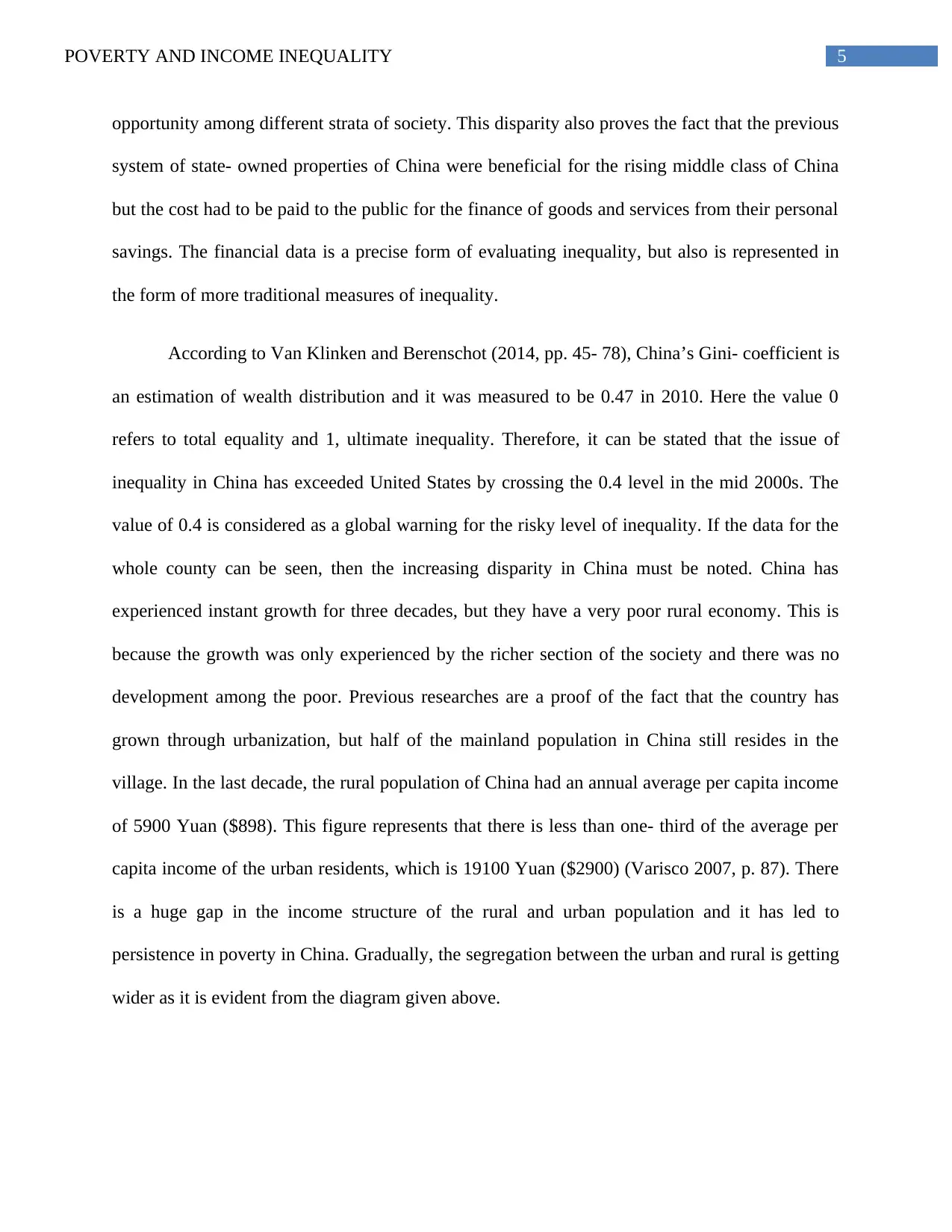
5POVERTY AND INCOME INEQUALITY
opportunity among different strata of society. This disparity also proves the fact that the previous
system of state- owned properties of China were beneficial for the rising middle class of China
but the cost had to be paid to the public for the finance of goods and services from their personal
savings. The financial data is a precise form of evaluating inequality, but also is represented in
the form of more traditional measures of inequality.
According to Van Klinken and Berenschot (2014, pp. 45- 78), China’s Gini- coefficient is
an estimation of wealth distribution and it was measured to be 0.47 in 2010. Here the value 0
refers to total equality and 1, ultimate inequality. Therefore, it can be stated that the issue of
inequality in China has exceeded United States by crossing the 0.4 level in the mid 2000s. The
value of 0.4 is considered as a global warning for the risky level of inequality. If the data for the
whole county can be seen, then the increasing disparity in China must be noted. China has
experienced instant growth for three decades, but they have a very poor rural economy. This is
because the growth was only experienced by the richer section of the society and there was no
development among the poor. Previous researches are a proof of the fact that the country has
grown through urbanization, but half of the mainland population in China still resides in the
village. In the last decade, the rural population of China had an annual average per capita income
of 5900 Yuan ($898). This figure represents that there is less than one- third of the average per
capita income of the urban residents, which is 19100 Yuan ($2900) (Varisco 2007, p. 87). There
is a huge gap in the income structure of the rural and urban population and it has led to
persistence in poverty in China. Gradually, the segregation between the urban and rural is getting
wider as it is evident from the diagram given above.
opportunity among different strata of society. This disparity also proves the fact that the previous
system of state- owned properties of China were beneficial for the rising middle class of China
but the cost had to be paid to the public for the finance of goods and services from their personal
savings. The financial data is a precise form of evaluating inequality, but also is represented in
the form of more traditional measures of inequality.
According to Van Klinken and Berenschot (2014, pp. 45- 78), China’s Gini- coefficient is
an estimation of wealth distribution and it was measured to be 0.47 in 2010. Here the value 0
refers to total equality and 1, ultimate inequality. Therefore, it can be stated that the issue of
inequality in China has exceeded United States by crossing the 0.4 level in the mid 2000s. The
value of 0.4 is considered as a global warning for the risky level of inequality. If the data for the
whole county can be seen, then the increasing disparity in China must be noted. China has
experienced instant growth for three decades, but they have a very poor rural economy. This is
because the growth was only experienced by the richer section of the society and there was no
development among the poor. Previous researches are a proof of the fact that the country has
grown through urbanization, but half of the mainland population in China still resides in the
village. In the last decade, the rural population of China had an annual average per capita income
of 5900 Yuan ($898). This figure represents that there is less than one- third of the average per
capita income of the urban residents, which is 19100 Yuan ($2900) (Varisco 2007, p. 87). There
is a huge gap in the income structure of the rural and urban population and it has led to
persistence in poverty in China. Gradually, the segregation between the urban and rural is getting
wider as it is evident from the diagram given above.
⊘ This is a preview!⊘
Do you want full access?
Subscribe today to unlock all pages.

Trusted by 1+ million students worldwide
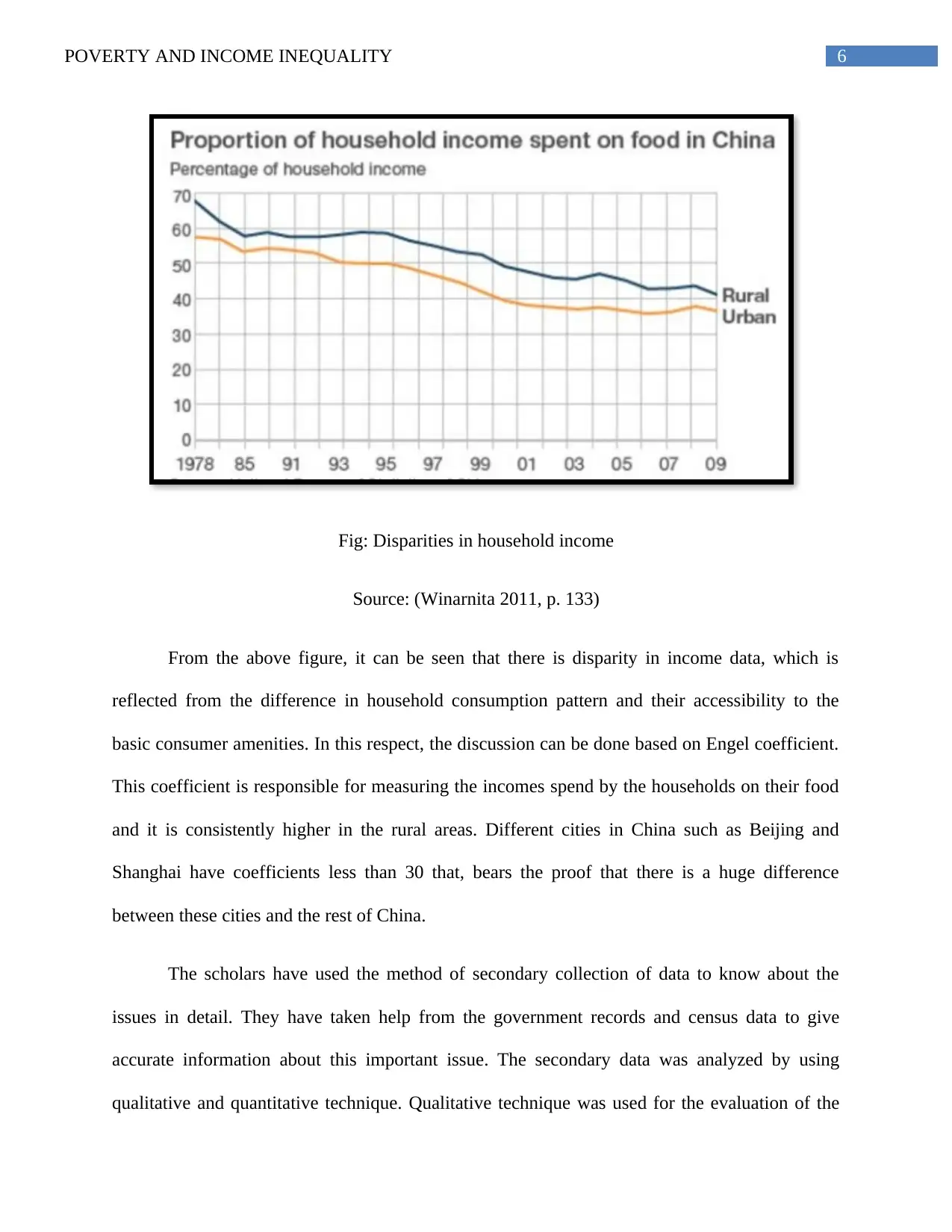
6POVERTY AND INCOME INEQUALITY
Fig: Disparities in household income
Source: (Winarnita 2011, p. 133)
From the above figure, it can be seen that there is disparity in income data, which is
reflected from the difference in household consumption pattern and their accessibility to the
basic consumer amenities. In this respect, the discussion can be done based on Engel coefficient.
This coefficient is responsible for measuring the incomes spend by the households on their food
and it is consistently higher in the rural areas. Different cities in China such as Beijing and
Shanghai have coefficients less than 30 that, bears the proof that there is a huge difference
between these cities and the rest of China.
The scholars have used the method of secondary collection of data to know about the
issues in detail. They have taken help from the government records and census data to give
accurate information about this important issue. The secondary data was analyzed by using
qualitative and quantitative technique. Qualitative technique was used for the evaluation of the
Fig: Disparities in household income
Source: (Winarnita 2011, p. 133)
From the above figure, it can be seen that there is disparity in income data, which is
reflected from the difference in household consumption pattern and their accessibility to the
basic consumer amenities. In this respect, the discussion can be done based on Engel coefficient.
This coefficient is responsible for measuring the incomes spend by the households on their food
and it is consistently higher in the rural areas. Different cities in China such as Beijing and
Shanghai have coefficients less than 30 that, bears the proof that there is a huge difference
between these cities and the rest of China.
The scholars have used the method of secondary collection of data to know about the
issues in detail. They have taken help from the government records and census data to give
accurate information about this important issue. The secondary data was analyzed by using
qualitative and quantitative technique. Qualitative technique was used for the evaluation of the
Paraphrase This Document
Need a fresh take? Get an instant paraphrase of this document with our AI Paraphraser
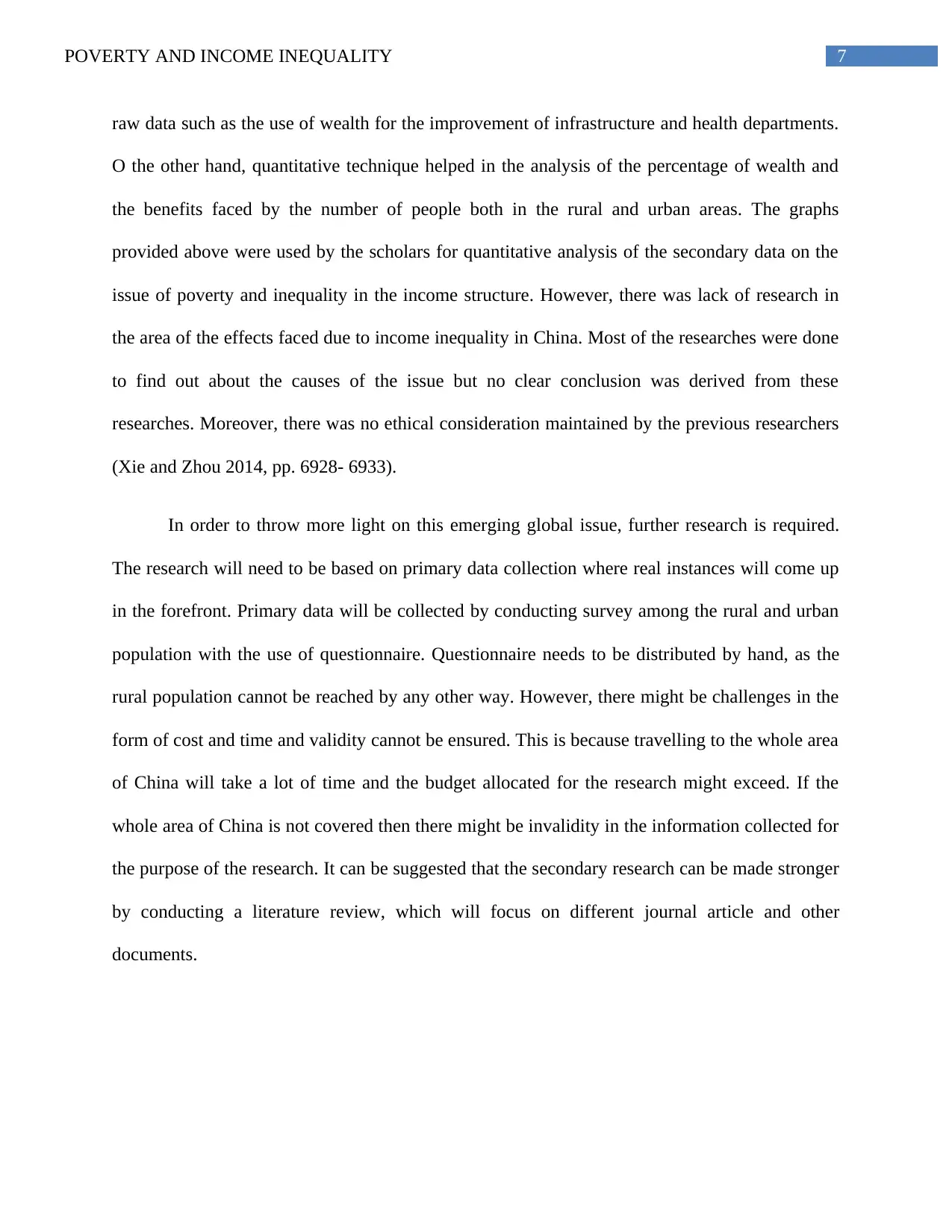
7POVERTY AND INCOME INEQUALITY
raw data such as the use of wealth for the improvement of infrastructure and health departments.
O the other hand, quantitative technique helped in the analysis of the percentage of wealth and
the benefits faced by the number of people both in the rural and urban areas. The graphs
provided above were used by the scholars for quantitative analysis of the secondary data on the
issue of poverty and inequality in the income structure. However, there was lack of research in
the area of the effects faced due to income inequality in China. Most of the researches were done
to find out about the causes of the issue but no clear conclusion was derived from these
researches. Moreover, there was no ethical consideration maintained by the previous researchers
(Xie and Zhou 2014, pp. 6928- 6933).
In order to throw more light on this emerging global issue, further research is required.
The research will need to be based on primary data collection where real instances will come up
in the forefront. Primary data will be collected by conducting survey among the rural and urban
population with the use of questionnaire. Questionnaire needs to be distributed by hand, as the
rural population cannot be reached by any other way. However, there might be challenges in the
form of cost and time and validity cannot be ensured. This is because travelling to the whole area
of China will take a lot of time and the budget allocated for the research might exceed. If the
whole area of China is not covered then there might be invalidity in the information collected for
the purpose of the research. It can be suggested that the secondary research can be made stronger
by conducting a literature review, which will focus on different journal article and other
documents.
raw data such as the use of wealth for the improvement of infrastructure and health departments.
O the other hand, quantitative technique helped in the analysis of the percentage of wealth and
the benefits faced by the number of people both in the rural and urban areas. The graphs
provided above were used by the scholars for quantitative analysis of the secondary data on the
issue of poverty and inequality in the income structure. However, there was lack of research in
the area of the effects faced due to income inequality in China. Most of the researches were done
to find out about the causes of the issue but no clear conclusion was derived from these
researches. Moreover, there was no ethical consideration maintained by the previous researchers
(Xie and Zhou 2014, pp. 6928- 6933).
In order to throw more light on this emerging global issue, further research is required.
The research will need to be based on primary data collection where real instances will come up
in the forefront. Primary data will be collected by conducting survey among the rural and urban
population with the use of questionnaire. Questionnaire needs to be distributed by hand, as the
rural population cannot be reached by any other way. However, there might be challenges in the
form of cost and time and validity cannot be ensured. This is because travelling to the whole area
of China will take a lot of time and the budget allocated for the research might exceed. If the
whole area of China is not covered then there might be invalidity in the information collected for
the purpose of the research. It can be suggested that the secondary research can be made stronger
by conducting a literature review, which will focus on different journal article and other
documents.
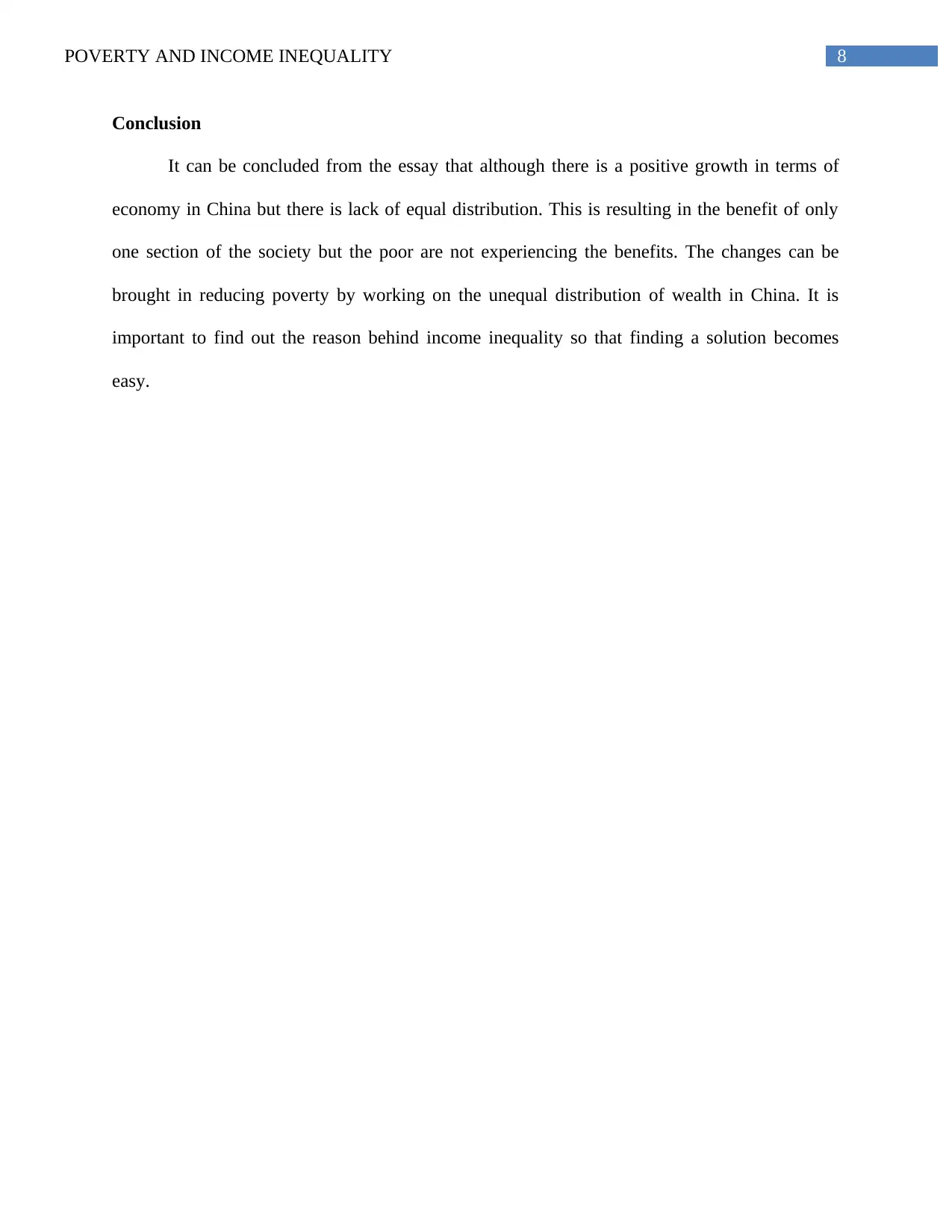
8POVERTY AND INCOME INEQUALITY
Conclusion
It can be concluded from the essay that although there is a positive growth in terms of
economy in China but there is lack of equal distribution. This is resulting in the benefit of only
one section of the society but the poor are not experiencing the benefits. The changes can be
brought in reducing poverty by working on the unequal distribution of wealth in China. It is
important to find out the reason behind income inequality so that finding a solution becomes
easy.
Conclusion
It can be concluded from the essay that although there is a positive growth in terms of
economy in China but there is lack of equal distribution. This is resulting in the benefit of only
one section of the society but the poor are not experiencing the benefits. The changes can be
brought in reducing poverty by working on the unequal distribution of wealth in China. It is
important to find out the reason behind income inequality so that finding a solution becomes
easy.
⊘ This is a preview!⊘
Do you want full access?
Subscribe today to unlock all pages.

Trusted by 1+ million students worldwide
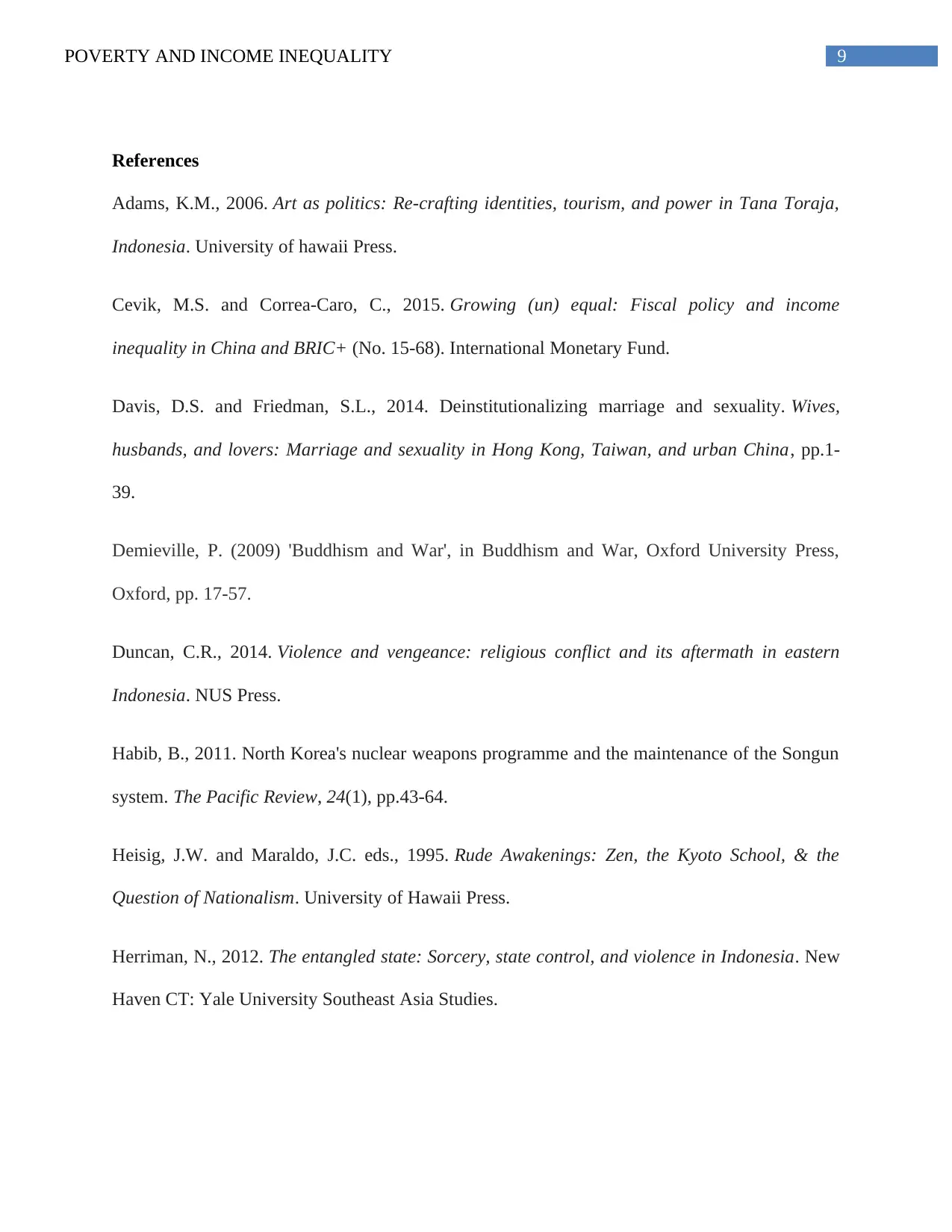
9POVERTY AND INCOME INEQUALITY
References
Adams, K.M., 2006. Art as politics: Re-crafting identities, tourism, and power in Tana Toraja,
Indonesia. University of hawaii Press.
Cevik, M.S. and Correa-Caro, C., 2015. Growing (un) equal: Fiscal policy and income
inequality in China and BRIC+ (No. 15-68). International Monetary Fund.
Davis, D.S. and Friedman, S.L., 2014. Deinstitutionalizing marriage and sexuality. Wives,
husbands, and lovers: Marriage and sexuality in Hong Kong, Taiwan, and urban China, pp.1-
39.
Demieville, P. (2009) 'Buddhism and War', in Buddhism and War, Oxford University Press,
Oxford, pp. 17-57.
Duncan, C.R., 2014. Violence and vengeance: religious conflict and its aftermath in eastern
Indonesia. NUS Press.
Habib, B., 2011. North Korea's nuclear weapons programme and the maintenance of the Songun
system. The Pacific Review, 24(1), pp.43-64.
Heisig, J.W. and Maraldo, J.C. eds., 1995. Rude Awakenings: Zen, the Kyoto School, & the
Question of Nationalism. University of Hawaii Press.
Herriman, N., 2012. The entangled state: Sorcery, state control, and violence in Indonesia. New
Haven CT: Yale University Southeast Asia Studies.
References
Adams, K.M., 2006. Art as politics: Re-crafting identities, tourism, and power in Tana Toraja,
Indonesia. University of hawaii Press.
Cevik, M.S. and Correa-Caro, C., 2015. Growing (un) equal: Fiscal policy and income
inequality in China and BRIC+ (No. 15-68). International Monetary Fund.
Davis, D.S. and Friedman, S.L., 2014. Deinstitutionalizing marriage and sexuality. Wives,
husbands, and lovers: Marriage and sexuality in Hong Kong, Taiwan, and urban China, pp.1-
39.
Demieville, P. (2009) 'Buddhism and War', in Buddhism and War, Oxford University Press,
Oxford, pp. 17-57.
Duncan, C.R., 2014. Violence and vengeance: religious conflict and its aftermath in eastern
Indonesia. NUS Press.
Habib, B., 2011. North Korea's nuclear weapons programme and the maintenance of the Songun
system. The Pacific Review, 24(1), pp.43-64.
Heisig, J.W. and Maraldo, J.C. eds., 1995. Rude Awakenings: Zen, the Kyoto School, & the
Question of Nationalism. University of Hawaii Press.
Herriman, N., 2012. The entangled state: Sorcery, state control, and violence in Indonesia. New
Haven CT: Yale University Southeast Asia Studies.
Paraphrase This Document
Need a fresh take? Get an instant paraphrase of this document with our AI Paraphraser
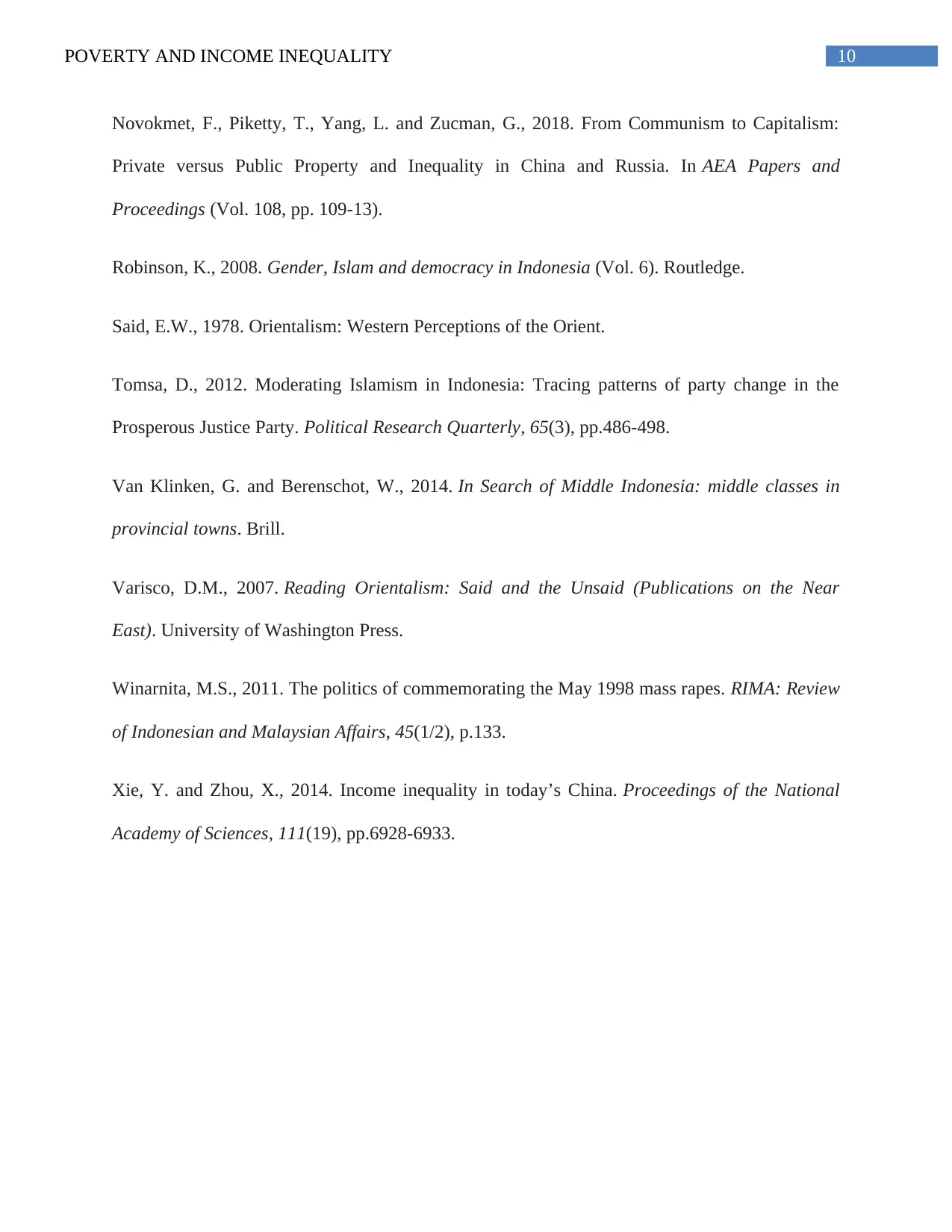
10POVERTY AND INCOME INEQUALITY
Novokmet, F., Piketty, T., Yang, L. and Zucman, G., 2018. From Communism to Capitalism:
Private versus Public Property and Inequality in China and Russia. In AEA Papers and
Proceedings (Vol. 108, pp. 109-13).
Robinson, K., 2008. Gender, Islam and democracy in Indonesia (Vol. 6). Routledge.
Said, E.W., 1978. Orientalism: Western Perceptions of the Orient.
Tomsa, D., 2012. Moderating Islamism in Indonesia: Tracing patterns of party change in the
Prosperous Justice Party. Political Research Quarterly, 65(3), pp.486-498.
Van Klinken, G. and Berenschot, W., 2014. In Search of Middle Indonesia: middle classes in
provincial towns. Brill.
Varisco, D.M., 2007. Reading Orientalism: Said and the Unsaid (Publications on the Near
East). University of Washington Press.
Winarnita, M.S., 2011. The politics of commemorating the May 1998 mass rapes. RIMA: Review
of Indonesian and Malaysian Affairs, 45(1/2), p.133.
Xie, Y. and Zhou, X., 2014. Income inequality in today’s China. Proceedings of the National
Academy of Sciences, 111(19), pp.6928-6933.
Novokmet, F., Piketty, T., Yang, L. and Zucman, G., 2018. From Communism to Capitalism:
Private versus Public Property and Inequality in China and Russia. In AEA Papers and
Proceedings (Vol. 108, pp. 109-13).
Robinson, K., 2008. Gender, Islam and democracy in Indonesia (Vol. 6). Routledge.
Said, E.W., 1978. Orientalism: Western Perceptions of the Orient.
Tomsa, D., 2012. Moderating Islamism in Indonesia: Tracing patterns of party change in the
Prosperous Justice Party. Political Research Quarterly, 65(3), pp.486-498.
Van Klinken, G. and Berenschot, W., 2014. In Search of Middle Indonesia: middle classes in
provincial towns. Brill.
Varisco, D.M., 2007. Reading Orientalism: Said and the Unsaid (Publications on the Near
East). University of Washington Press.
Winarnita, M.S., 2011. The politics of commemorating the May 1998 mass rapes. RIMA: Review
of Indonesian and Malaysian Affairs, 45(1/2), p.133.
Xie, Y. and Zhou, X., 2014. Income inequality in today’s China. Proceedings of the National
Academy of Sciences, 111(19), pp.6928-6933.
1 out of 11
Related Documents
Your All-in-One AI-Powered Toolkit for Academic Success.
+13062052269
info@desklib.com
Available 24*7 on WhatsApp / Email
![[object Object]](/_next/static/media/star-bottom.7253800d.svg)
Unlock your academic potential
Copyright © 2020–2025 A2Z Services. All Rights Reserved. Developed and managed by ZUCOL.





